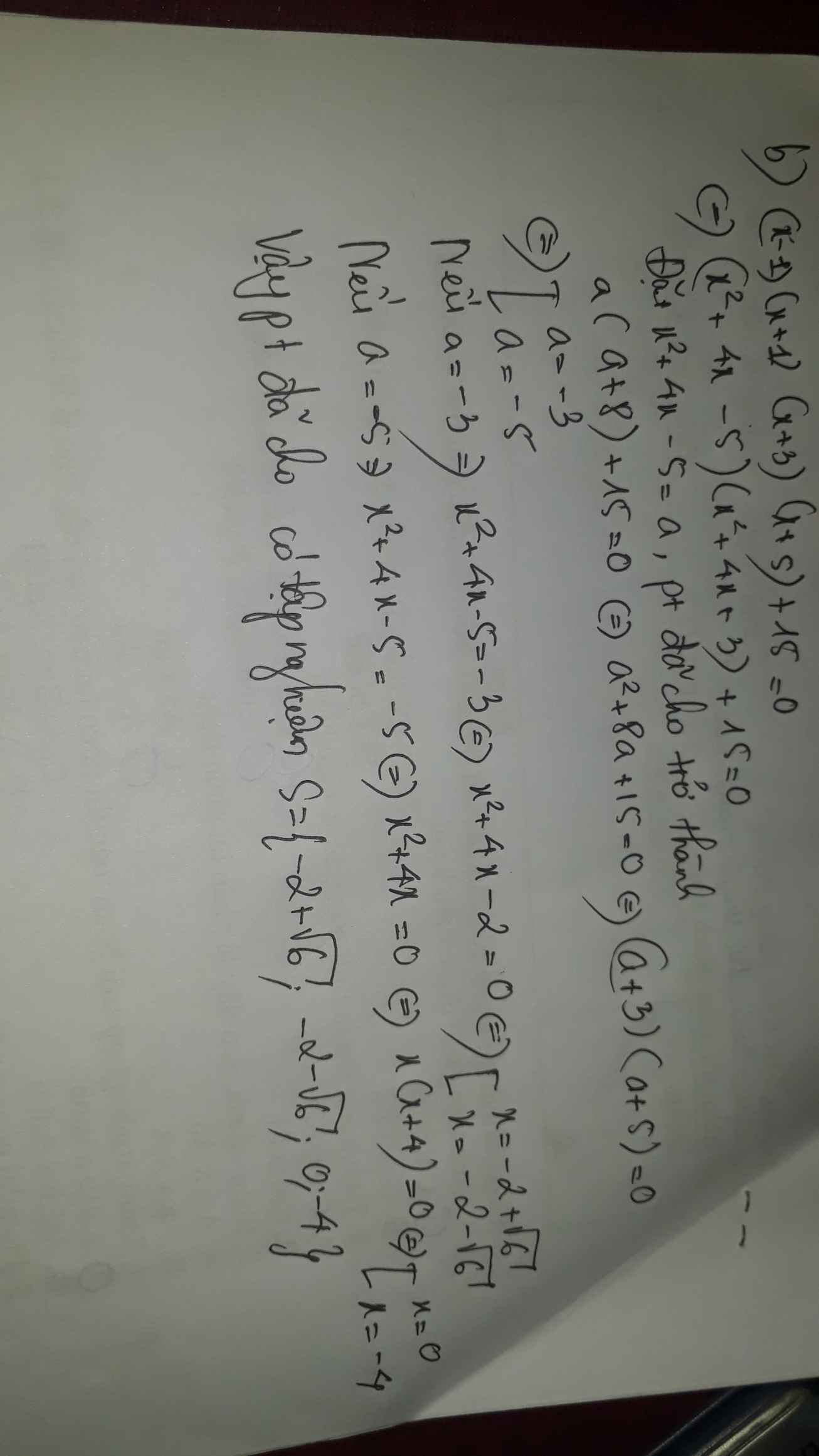Hãy nhập câu hỏi của bạn vào đây, nếu là tài khoản VIP, bạn sẽ được ưu tiên trả lời.

a) (x - 1)3 + (2 - x)(4 + 2x + x2) + 3x(x + 2) = 12
<=> x3 - 2x2 + x - x2 + 2x - 1 + 8 + 4x + 2x2 - 4x - 2x2 + 3x2 + 6x = 17
<=> 9x + 7 = 17
<=> 9x = 17 - 7
<=> 9x = 10
<=> x = \(\frac{10}{9}\)
b) (x + 2)(x2 - 2x + 4) - x(x2 - 2) = 15
<=> x3 - 2x2 + 4x + 2x2 - 4x + 8 - x3 + 2x = 15
<=> 2x + 8 = 15
<=> 2x = 15 - 8
<=> 2x = 7
<=> x = \(\frac{7}{2}\)
c) (x - 3)3 - (x - 3)(x2 + 3x + 9) + 9(x2 + 1)2 = 15
<=> x3 + 45x - 18 - x3 - 3x2 - 9x + 3x2 + 9x + 27 = 15
<=> 45x + 9 = 15
<=> 45x = 15 - 9
<=> 45x = 6
<=> x = \(\frac{6}{45}\)
d) x(x - 5)(x + 5) - (x + 2)(x2 - 2x + 4) = 3
<=> x3 - 25x - x3 + 2x2 - 4x - 8 = 3
<=> -25x - 8 = 3
<=> -25x = 3 + 8
<=> -25x = 11
<=> x = \(-\frac{11}{25}\)

1:
a: =>3x=6
=>x=2
b: =>4x=16
=>x=4
c: =>4x-6=9-x
=>5x=15
=>x=3
d: =>7x-12=x+6
=>6x=18
=>x=3
2:
a: =>2x<=-8
=>x<=-4
b: =>x+5<0
=>x<-5
c: =>2x>8
=>x>4

a) \(5x\left(x-3\right)^2-5\left(x-1\right)^3+15\left(x-4\right)\left(x+4\right)\le10\)
\(\Leftrightarrow5x\left(x^2-6x+9\right)-5\left(x^3-3x^2+3x-1\right)+15\left(x^2-16\right)\le10\)
\(\Leftrightarrow5x^3-30x^2+45x-5x^3+15x^2-15x+5+15x^2-240\le10\)
\(\Leftrightarrow\left(5x^3-5x^3\right)-\left(30x^2-15x^2-15x^2\right)-\left(45x-15x\right)+5-240\le10\)
\(\Leftrightarrow30x-235\le10\)
\(\Leftrightarrow30x\le10+235\)
\(\Leftrightarrow30x\le245\)
\(\Leftrightarrow30x:30\le245:30\)
\(\Leftrightarrow x\le\dfrac{49}{6}\)
Vậy nghiệm của bất phương trình là: \(x\le\dfrac{49}{6}\)
b) \(\left(3x-2\right)\left(9x^2+6x+4\right)+27x\left(\dfrac{1}{3}-x\right)\left(\dfrac{1}{2}+x\right)\ge1\)
\(\Leftrightarrow27x^3-8+27x\left(\dfrac{1}{9}-x^2\right)\ge1\)
\(\Leftrightarrow27x^3-8+3x-27x^3\ge1\)
\(\Leftrightarrow\left(27x^3-27x^3\right)-8+3x\ge1\)
\(\Leftrightarrow-8+3x\ge1\)
\(\Leftrightarrow3x\ge1+8\)
\(\Leftrightarrow3x\ge9\)
\(\Leftrightarrow3x:3\ge9:3\)
\(\Leftrightarrow x\ge3\)
Vậy nghiệm của bất phương trình là \(x\ge3\)
a: =>5x(x^2-6x+9)-5(x^3-3x^2+3x-1)+15(x^2-16)<=10
=>5x^3-30x^2+45x-5x^3+15x^2-15x+5+15x^2-240<=10
=>30x-235<=10
=>30x<=245
=>x<=49/6
b: =>27x^3-8+27x(1/9-x^2)>=1
=>27x^3-8+3x-27x^3>=1
=>3x>=9
=>x>=3

a)<=>(x^2+x-3)(x^2+x-2)-12=(x-2)(x+3)(x^2+x+1)
TH1:=>x-2=0
=>x=2
TH2:x+3=0
=>x=-3
dựa vô bệt thức ta thấy
D<0=> phương trình ko có nghiệm thực
=>x=-3 hoặc 2
nhớ tick nhé

c) \(\left(x+1\right)\left(x+2\right)\left(x+4\right)\left(x+5\right)=40\)
\(\Leftrightarrow\)\(\left(x^2+6x+5\right)\left(x^2+6x+8\right)-40=0\)
Đặt \(x^2+6x+5=t\) ta có:
\(t\left(t+3\right)-40=0\)
\(\Leftrightarrow\)\(t^2+3t-40=0\)
\(\Leftrightarrow\)\(\left(t-5\right)\left(t+8\right)=0\)
\(\Leftrightarrow\)\(\orbr{\begin{cases}t-5=0\\t+8=0\end{cases}}\)
Thay trở lại ta có: \(\orbr{\begin{cases}x^2+6x=0\\x^2+6x+13=0\end{cases}}\)
(*) \(x^2+6x=0\)
\(\Leftrightarrow\)\(x\left(x+6\right)=0\)
\(\Leftrightarrow\)\(\orbr{\begin{cases}x=0\\x+6=0\end{cases}}\)\(\Leftrightarrow\)\(\orbr{\begin{cases}x=0\\x=-6\end{cases}}\)
(*) \(x^2+6x+13=0\)
\(\Leftrightarrow\)\(\left(x+3\right)^2+4=0\) (vô lý)
Vậy......

a) \(8 - \left( {x - 15} \right) = 2.\left( {3 - 2x} \right)\)
\(8 - x + 15 = 6 - 4x\)
\( - x + 4x = 6 - 8 - 15\)
\(3x = - 17\)
\(x = \left( { - 17} \right):3\)
\(x = \dfrac{{ - 17}}{3}\)
Vậy nghiệm của phương trình là \(x = \dfrac{{ - 17}}{3}\).
b) \( - 6\left( {1,5 - 2u} \right) = 3\left( { - 15 + 2u} \right)\)
\( - 9 + 12u = - 45 + 6u\)
\(12u - 6u = - 45 + 9\)
\(u = \left( { - 36} \right):6\)
\(6u = - 36\)
\(u = - 6\)
Vậy nghiệm của phương trình là \(u = - 6\).
c) \({\left( {x + 3} \right)^2} - x\left( {x + 4} \right) = 13\)
\(\left( {{x^2} + 6x + 9} \right) - \left( {{x^2} + 4x} \right) = 13\)
\({x^2} + 6x + 9 - {x^2} - 4x = 13\)
\(\left( {{x^2} - {x^2}} \right) + \left( {6x - 4x} \right) = 13 - 9\)
\(2x = 4\)
\(x = 4:2\)
\(x = 2\)
Vậy nghiệm của phương trình là \(x = 2\).
d) \(\left( {y + 5} \right)\left( {y - 5} \right) - {\left( {y - 2} \right)^2} = 5\)
\(\left( {{y^2} - 25} \right) - \left( {{y^2} - 4y + 4} \right) = 5\)
\({y^2} - 25 - {y^2} + 4y - 4 = 5\)
\(\left( {{y^2} - {y^2}} \right) + 4y = 5 + 4 + 25\)
\(4y = 34\)
\(y = 34:4\)
\(y = \dfrac{{17}}{2}\)
Vậy nghiệm của phương trình là \(y = \dfrac{{17}}{2}\).

b: TH1: x<2
Pt sẽ là 2-x+3-x=15
=>5-2x=15
=>-2x=-10
hay x=5(loại)
TH2: 2<=x<3
Pt sẽ là x-2+3-x=15
=>1=15(loại)
TH3: x>=3
Pt sẽ là x-2+x-3=15
=>2x-5=15
=>x=10(nhận)
c: TH1: x<-1
Pt sẽ là 5(-x-1)-(3-x)=x+12
=>-5x-5-3+x=x+12
=>-4x-8=x+12
=>-5x=20
hay x=-4(nhận)
TH2: -1<=x<3
Pt sẽ là 5(x+1)-(3-x)=x+12
=>5x+5-3+x=x+12
=>6x+2=x+12
=>5x=10
=>x=2(nhận)
TH2: x>=3
Pt sẽlà 5(x+1)-(x-3)=x+12
=>5x+5-x+3=x+12
=>4x+8=x+12
=>3x=4
hay x=4/3(loại)

1) \(2\left(x+3\right)>5\left(x-1\right)+2\Leftrightarrow2x+6>5x-5+2\Leftrightarrow3x>9\Leftrightarrow x>3\)
2) \(x^2-x\left(x+2\right)>3x-10\)
\(\Leftrightarrow x^2-x^2-2x>3x-10\Leftrightarrow5x< 10\Leftrightarrow x< 2\)
3) \(x\left(x-5\right)< \left(x+1\right)^2\)
\(\Leftrightarrow x^2-5x< x^2+2x+1\Leftrightarrow7x>-1\Leftrightarrow x>-\dfrac{1}{7}\)
4) \(15-2\left(x-7\right)< 2\left(x-3\right)-6\)
\(\Leftrightarrow15-2x+14< 2x-6-6\Leftrightarrow4x>41\Leftrightarrow x>\dfrac{41}{4}\)
1: Ta có: \(2\left(x+3\right)>5\left(x-1\right)+2\)
\(\Leftrightarrow2x+6>5x-5+2\)
\(\Leftrightarrow-3x>-9\)
hay x<3
2: Ta có: \(x^2-x\left(x+2\right)>3x-10\)
\(\Leftrightarrow x^2-x^2-2x>3x-10\)
\(\Leftrightarrow-5x>-10\)
hay x<2
3: Ta có: \(x\left(x-5\right)\le\left(x+1\right)^2\)
\(\Leftrightarrow x^2-5x-x^2-2x-1\ge0\)
\(\Leftrightarrow-7x\ge1\)
hay \(x\le-\dfrac{1}{7}\)

\(a,2x-5=-x+4\\ \Leftrightarrow3x=9\\ \Leftrightarrow x=3\\ b,\left(4x-10\right)\left(25+5x\right)=0\\ \Leftrightarrow\left[{}\begin{matrix}4x-10=0\\25+5x=0\end{matrix}\right.\\ \Leftrightarrow\left[{}\begin{matrix}x=\dfrac{5}{2}\\x=-5\end{matrix}\right.\\ c,\dfrac{x}{3}-\dfrac{2x+1}{2}=\dfrac{x}{6}-x\\ \Leftrightarrow\dfrac{2x}{6}-\dfrac{3\left(2x+1\right)}{6}-\dfrac{x}{6}+\dfrac{6x}{6}=0\\ \Leftrightarrow2x-6x-3-x+6x=0\\ \Leftrightarrow x-3=0\\ \Leftrightarrow x=3\)
d, ĐKXĐ:\(x\ne-2,x\ne3\)
\(1+\dfrac{x}{3-x}=\dfrac{5x}{\left(x+2\right)\left(3-x\right)}+\dfrac{2}{x+2}\\ \Leftrightarrow\dfrac{\left(x+2\right)\left(3-x\right)}{\left(x+2\right)\left(3-x\right)}+\dfrac{x\left(x+2\right)}{\left(x+2\right)\left(3-x\right)}-\dfrac{5x}{\left(x+2\right)\left(3-x\right)}-\dfrac{2\left(3-x\right)}{\left(x+2\right)\left(3-x\right)}=0\\ \Leftrightarrow\dfrac{-x^2+x+6}{\left(x+2\right)\left(3-x\right)}+\dfrac{x^2+2x}{\left(x+2\right)\left(3-x\right)}-\dfrac{5x}{\left(x+2\right)\left(3-x\right)}-\dfrac{6-2x}{\left(x+2\right)\left(3-x\right)}=0\)
\(\Leftrightarrow\dfrac{-x^2+x+6+x^2+2x-5x-6+2x}{\left(x+2\right)\left(3-x\right)}=0\\ \Rightarrow0=0\left(luôn.đúng\right)\)



Chọn đáp án A